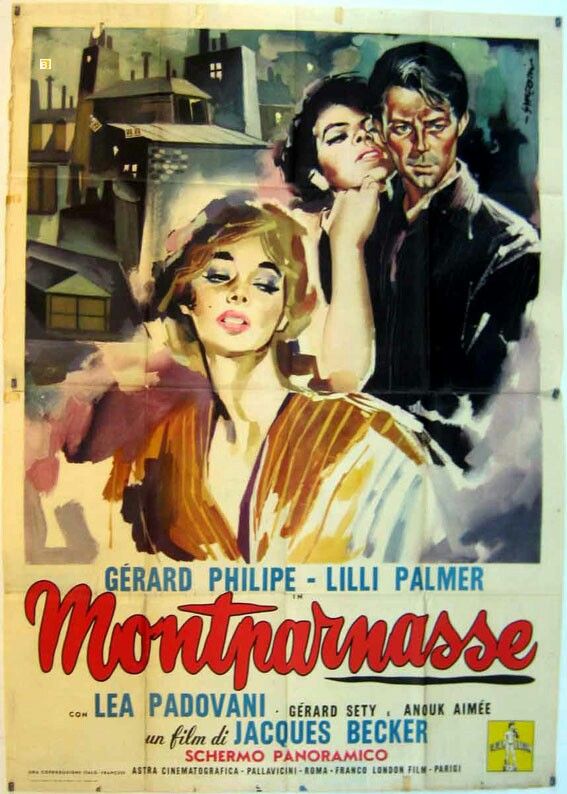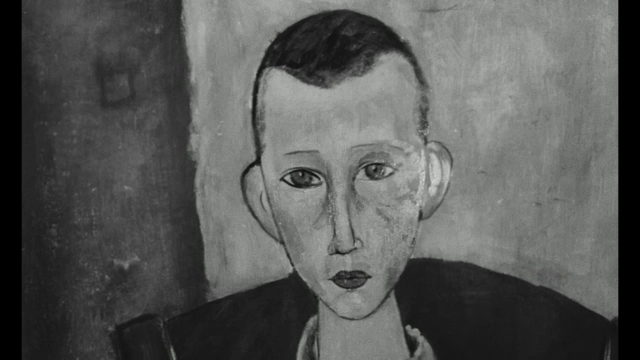
Going to a Max Ophüls film always feels to me like going to church – and this sense came again to me while watching the film Les amants de Montparnasse. Ophüls wrote the screenplay for and was originally intending to direct, however when he tragically died of rheumatic fever, his friend Jacques Becker took over the role of director.
Although friends, Becker’s style of directing was radically different from Ophüls. For example, the moving, intricate camera work of Ophüls became a mostly stationary camera – the canvas was smaller in Becker’s hands – smaller but as a result, more intense.
And before long, Ophüls’ interests and themes start to become evident in the sharp and insightful screenplay – ostensibly the film is a biopic of the famous Italian artist Amedeo Modigliani – the last few years of his life (from late 1916 to 1920). The first part of the film is the standard (almost cliche) story of the poor starving artist who is brilliant but self-destructive, and his talent only seen by his few close friends. The opening scenes are so familiar they could be an early draft of An American in Paris (An Italian in Paris?).

But as the story plays out, the alcoholic, tubercular version of Modigliani is no Gene Kelly – and we (the audience) start to get annoyed, first at Modigliani for being such a louche and a moocher, and then our annoyance spreads toward his friends and lovers for putting up with his reckless, boorish and violent behavior.
 But this is how Ophüls often works – first he shows the shortcomings of the characters and then gives us reasons to sympathize with them, even love them because of their failings.
But this is how Ophüls often works – first he shows the shortcomings of the characters and then gives us reasons to sympathize with them, even love them because of their failings.
The second half of the film takes us away from the biographical elements, and we enter into a more allegorical narrative that becomes focused less on Modigliani than the potential commerce that his paintings may bring.
And when the desperate and starving painter and his friends go to a hotel for a potential buyer, we meet the REAL American in Paris – not Gene Kelly, but a rich Hearst-like banker who is buying art and bric-à-brac right and left – this banker is not without some sympathy himself – he (unlike his friends) sees the talent in the paintings, describing the powerful attraction of the portraits with their ‘hollow eyes,’ but can only (Don Draper-like) see the value of these faces and images as a potential ad campaign – a new line of perfume perhaps.

In horror, Modigliani can only edge away from the man – and in that moment, the sale, and perhaps Modigliani’s health – and life – pass through his fingers. The artist rejecting the sale of his paintings to this man, denies himself money that might save his life.
And then it struck me why, for me, going to an Ophüls movie is like going to church – in his movies, Ophüls is giving us his version of the Beatitudes – in the same humanist (and paradoxical style) as Jesus described –
“Blessed are the poor in spirit,
for theirs is the kingdom of heaven.
Blessed are they who mourn,
for they shall be comforted.
Ophüls would no doubt have his own, more secular, list – such as:
Blessed are they who feel the stirring of their heart, for they shall feel true joy as others will never do.
To me, each Ophüls film is a parable-like story exploring the lives of wounded souls. It’s important to understand that these souls are wounded not because of heartbreak, but rather from the opposite happening, that is, the damage has happened because of the heart has closed itself off from feelings. This for Ophüls is the greatest of all sins because this act deprives one from the ability to love and embrace who we are and what we can feel, which is the greatest of all gifts we have in this world.
 In his films. Ophüls guides these wounded characters through a perilous journey, and those who are able to hear and respond to the call of their hearts may find themselves at the end physically degraded, perhaps even near death. Often they’ve lost all they thought was important, but have received a personal form of blessing of far greater importance, they have found themselves.
In his films. Ophüls guides these wounded characters through a perilous journey, and those who are able to hear and respond to the call of their hearts may find themselves at the end physically degraded, perhaps even near death. Often they’ve lost all they thought was important, but have received a personal form of blessing of far greater importance, they have found themselves.
And Modigliani, in his moment of truth, realizes that despite his self-proclaimed callous rejection of any importance of his work, really does care about his paintings, he cares deeply and passionately. By passing up a sale to a man whose only interest was marketing them to make more money for himself, Modigliani may have signed his death certificate, but by doing so he has reclaimed himself, and as an artist, can there be anything more important?
 However there are some who will never receive this blessing or redemption – in this film, this character is be a man named Morel, who has been lingering patiently in the shadows, watching Modigliani, knowing that the moment of his death is the moment to buy his paintings. He has committed the unpardonable sin of both having the artistic eye to see his greatness, and the hardness of his heart to do nothing for the man when it is in his means to do so.
However there are some who will never receive this blessing or redemption – in this film, this character is be a man named Morel, who has been lingering patiently in the shadows, watching Modigliani, knowing that the moment of his death is the moment to buy his paintings. He has committed the unpardonable sin of both having the artistic eye to see his greatness, and the hardness of his heart to do nothing for the man when it is in his means to do so.
There is evil in Ophüls’ world, and it is in this sphere of commerce, societal mores, and politics where evil lurks and can do great harm. And in real life, those who move in that circle will have little interest in either Ophüls or his films. But for the rest of us, his flawed but lovable characters in his films are twice-blessed, once by Ophüls, who has graced the screen with their presence, and the second time by we the audience, who appreciate that the characters are versions of ourselves, trying to open our hearts to the world, not always succeeding, but always trying.




One thought on “Les amants de Montparnasse (1958)”
Excellent observations, Lokke, of one of the most sublime of all directors. Beg pardon if my thoughts on Ophuls and the fundamental dynamic you describe are a little flaky—I just woke up. Anyway, the only Ophuls I have seen more than once is The Earrings of Madame de…, in which all members of the romantic triangle and their fates are shown to hang in the balance as their hearts open and close to each other, but except for the giddy, headlong rush of her romance, the doors swing back and forth but not in sync, and Madame ends up stranded and emotionally abandoned by both men, without the connection necessary to sustain life. In some ways Ophuls gave us Rohmer, who gives us the same survival search of the heart for connection but his characters are a smidge more self-aware, which allows us to hear their rationalizations for their needs and irrational acts in service of this search. And the other director who comes to mind, who documents the urgent basic need for love and connection, is Nicholas Ray. Ray, in Rebel…, In a Lonely Place, The Lusty Men, chronicles the ravages of being without this love connection (to coin a phrase, for which I humbly beg pardon), the urgent drive to find it, and often the failure to achieve it. He depicts this as desperate, heroic, and due to the results of character and fate. He shows us that this failure can be fatal, as it is for poor Plato in Rebel… I also think it would be interesting to compare this essential dynamic for Ophuls with Borzage, another director for whom the drive to connect and love transcends the drive for survival. In Borzage, physical survival is not trivial, but it is dwarfed by the emotional and spiritual survival of surrendering to love, a love so imperishable and all-consuming that death is tragic but not the main event. If that makes any sense. Anyway, lovely piece on a movie I don’t know but will seek out.